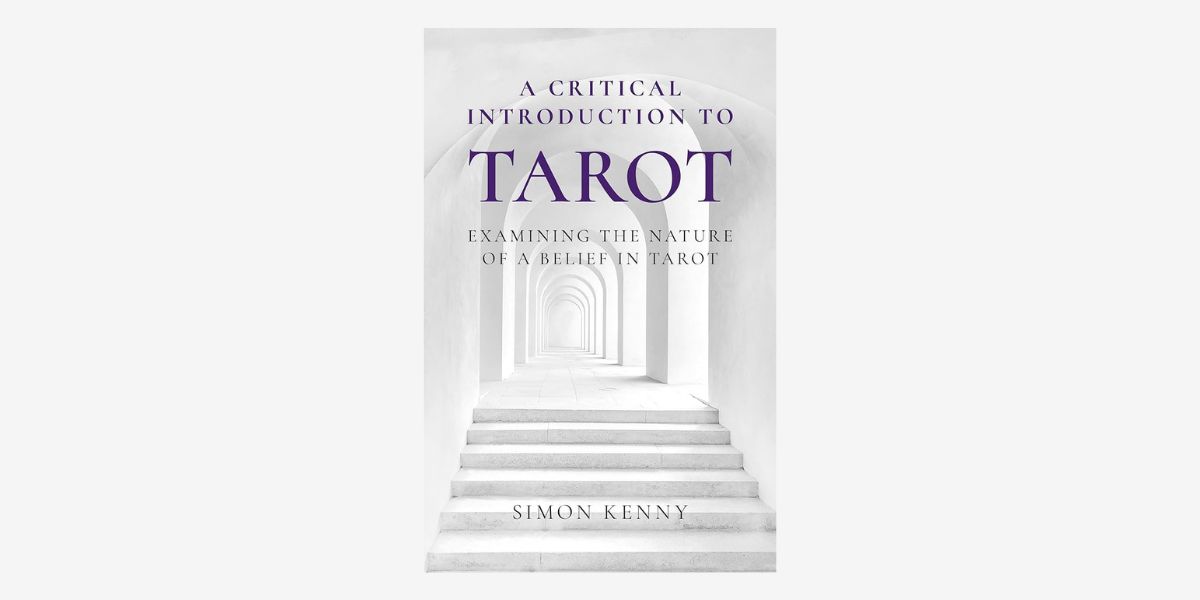
A Critical Introduction to Tarot: Examining the Nature of a Belief in Tarot, by Simon Kenny
IFF Books, 1803413921, 248 pages, January 2024
Simon Kenny wrote A Critical Introduction to Tarot: Examining the Nature of a Belief in Tarot after getting a tarot reading from a woman named Jo Lluque. He bought the Modern Witch Tarot Deck, “which sparked my interest in Tarot as a research topic.”1
“My approach here is to make the unknown known insofar as that is within my ability. It should be evident that the style I employ, while comparative, is to seek clarity of theory as informed by the available facts and compassion for those studied. My study of the Tarot has brought me on an exciting and unexpected journey through the many topics it touches.”2
Kenny’s background is in blogging about technology and political philosophy. As an author, technologist, and educator dedicated to asking probing questions to promote technical thinking, he applies his expertise to the tarot for the purpose of this book. He currently lives in Galway, Ireland and is a member of International Playing-Card Society, The Irish Writers Centre, and Writing.ie. You can learn more about him at this website.
A Critical Introduction to Tarot is very well planned and thoughtfully constructed, much like a research paper or dissertation. The reference material is always available; I found myself checking the References over and over again as I made my way through the book. He utilizes the Rider-Waite-Smith deck for all images in this book, although he mentions Aleister Crowley and his Thoth Deck in several passages.
The chapter “Randomness and Projection” discusses the practice and different forms of shuffling cards.
This discussion was interesting, as he shared viewpoints from different readers, as well as statistical data on the randomness of shuffling and drawing cards. He interviewed a number of leading tarot experts, including two of my favorites: Benebell Well and Cynthia Giles. And what book on tarot is complete without a discussion of archetypes, Jung and his influence on tarot?
“The Tarot Major Arcana are well established in the literature as representative of archetypes in the Jungian sense. For example, the above archetype of Mother is represented as the Empress . . . The Hermit often stands for solitude, wisdom and even time itself.”3
In another chapter, he talks extensively about Satanism and Freemasonry and the tie-in with tarot, including the Order of the Golden Dawn, which used tarot cards as part of their teachings:
“A divinatory reading was one of the exams taken to achieve the sixth grade of ‘Adeptus Minor”, the highest grade for which any details are known for certain, as documented by Freemason Archivist Israel Regardie. Initiates were even required to create their own tarot deck from scratch, painting or illustrating every card.”4
Kenny references all of the parts of tarot, from the importance of pairs of opposites to magic and witchcraft to randomness. On the subject of evil in the cards, he presents information on the symbols, history, and other references to evil, but refuses to assign any evil intent or significance. However, he leaves it to each reader or practitioner to find his or her own meaning in the symbology of the cards.
My favorite chapter is “Chapter 3-Layers of Meaning”. Here, Kenny covers numbers one to ten and the meaning and symbolism of the numbers in the major and minor arcana. The interesting facts and insights he shares about these numbers are quite interesting. For example, did you know that 10 = 1+2+3+4? He also talks about the magical number 7 and how it relates to the seven original planets, the sevenfold path, and “an old idea that life proceeds in phases of seven years, which likely originates in the widespread notion of the sevenfold spiritual path.”5
Kenny includes a very basic Table of Contents with chapter titles. In the back of the book, he lists all of the figures or graphics that he presents in the book, including the original source, author, and page number. Next, he shares references for each chapter, with the source, author, book and page number given. This alone is priceless for those who wish to dive deeper into any of the areas Kenny discusses. Lastly, he includes a seven-page Bibliography for even more reference material.
A Critical Introduction to Tarot is great for anyone who would like a deeper dive into tarot, particularly its origins and symbolism. It would probably best suit a seasoned tarot card reader or student of tarot. I plan to keep it on hand and weave some of the numerological information in my readings. I feel that I benefit from every book I read, especially those that challenge my beliefs. This book has helped me reframe my love of tarot and deepened my knowledge of its rich history.

PJ Spur is an author, intuitive, spiritual mentor, astrologer, and hypnotist. She does tarot & oracle card readings, natal chart readings, grief coaching, and relationship healing. She also has hosted a weekly “Coffee & Cards” event with her Soul Compass Community for the past four years. Her book Navigating Grief with Grace is available on Amazon. Learn more at www.dearpj.com
